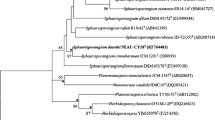Summary
Elytrosporangium (Greek Elytron, pod), a new genus of Actinomycetales from soil, placed in the family ActinoplanaceaeCouch, and its type species,E. brasiliense, are described. The main characteristic of the new genus is the production, in the substratal mycelium, of pod-shaped sporangia (merosporangia) with non-motile, globose, subglobose, to more or less cylindrical sporangiospores in chains. In addition, aerial mycelium with spores in chains, as inStreptomyces, is produced.
Zusammenfassung
Elytrosporangium (griechisch: Elytron, Schote) eine neue Gattung von Actinomycetels des Bodens wird hier zusammen mit der ArttypeE. brasiliense beschrieben. Das Hauptmerkmal der genannten Gattung ist die Erzeugung von Sporangien in Schotenform (Merosporangien) im vegetativen Myzel. Die Sporangien bilden sich sowohl am Ende von Haupthyphen als auch in kleinen seitlichen Zweigen, einzeln oder als Trauben, von zwei bis fünf. Die Sporangiosporen bilden eine Kette, die Basale mehr oder weniger zylindrisch und die übrigen fast kugelförmig. Luftmyzel mit Ketten von Konidien können erzeugt werden wie inStreptomyces. Wir betrachten die beschriebene Gattung als zur Familie Actinoplanaceae gehörend.
Die Arttype wurde isoliert von Bodenproben welche gesammelt wurden in einen Bodenprofil von 45 cm Tiefe in Verfolg des Programms einer Mikrobiologischen Prospektion des Bodens im Nordosten von Brasilien welches IMUR gemeinsam mit anderen brasilianischen wissenschaftlichen Körperschaften ausführt.
Sumário
Elytrosporangium (grego Elytron, vágem), um novo gênero de Actinomycetales do solo é descrito, juntamente com sua espécie tipo,E. brasiliense, A principal característica do gênero em foco é a produção de esporângios em forma de vágem (merosporângios), no micélio vegetativo. Os esporângios formam-se tanto na extremidade de hifas principais como na de pequenos ramos laterais, isoladamente ou em cachos de dois a cinco.
Os esporangiosporos constituem uma cadeia, os basais sendo mais ou menos cilíndricos e os demais globosos ou subglobosos.
Um micélio aéreo exibindo cadeias de conídios pode ser produzido, como emStreptomyces.
Consideramos o gênero em causa como integrante da familia Actinoplanaceae. A espécie tipo foi isolada de amostra de solo coletada num perfil, a 45 cm de profundidade, como decorrência de programa de prospecção microbiológica dos solos do Nordeste do Brasil que o IMUR vem desenvolvendo em colaboração com entidades científicas brasileiras.
Similar content being viewed by others
References
Couch, J. N. 1963. Some new genera and species of the Actinoplanaceae. Jour. Elisha Mitchell Sci. Soc.79: 53–70.
Henssen, A. 1957. Arch. Mikrobiol.26, 373–414. ApudWaksman, S. A. 1961. The Actinomycetes, Vol. II, The Williams & Wilkins Co., Baltimore, page 309.
Kuster, E. 1959. Outline of a comparative study of criteria used in characterization of the actinomycetes. Int. Bull. bact. Nomencl. and Taxon.9: 98–104 (Apud Methods Manual, International Streptomyces Project. Program Director:Elwood B. Shirling, Ohio Wesleyan University, 1964).
Lawrence, C. H. 1956. A method of isolating actinomycetes from scabby potato tissue and soil with minimal contamination. Canad. J. Bot.4: 44–47. ApudJohnson, L. F., E. A. Curl, J. H. Bond & H. A. Fribourg. 1959. Methods for Studying Soil Microflora — Plant Disease Relationships, page 8. Burgess Publishing Co., Minn.
Pridham, T. G. &D. Gottlieb. 1948. The utilization of carbon compounds by some Actinomycetales as an aid for species determination. J. Bacteriol.56: 107–114.
Pridham, T. G., P. Anderson, C. Foyle, L. A. Lindenfelser, C. W. Hesseltine &R. G. Benedict. 1956–1957. A selection of media for maintenance and taxonomic study of streptomycetes. Antib. Ann. 947–953.
Pridham, T. G. &A. J. Lyons Jr. 1961.Streptomyces albus (Rossi-Doria) Waksman et Henrici: Taxonomic study of strains labeledStreptomyces albus. J. Bacteriol.81: 431–441 (Apud Methods Manual of the ISP, op. cit.).
Shinobu, R. 1958. Physiological and cultural study for the identification of soil actinomycete species. Mem. Osaka Univ. B. nat. Sci.7: 1–76 (Modified) (Apud Methods Manual of the ISP, op. cit.).
Waksman, S. A. 1961. The Actinomycetes, Vol. II. The Williams & Wilkins Co., Baltimore.
Author information
Authors and Affiliations
Additional information
IMUR, Publ. no. 467.
Rights and permissions
About this article
Cite this article
Falcão de Morais, J.O., Chaves Batista, A. & Massa, D.M.G. Elytrosporangium: A new genus of the actinomycetales. Mycopathologia et Mycologia Applicata 30, 161–171 (1966). https://doi.org/10.1007/BF02130366
Issue Date:
DOI: https://doi.org/10.1007/BF02130366




